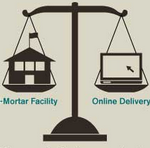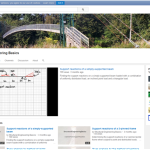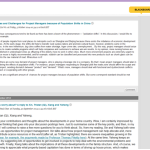This post arose from a seminar on “Blended Learning” held for probationary academics in  the School of MACE at the University of Manchester in October 2014. In it myself and Professor Andy Gale gave short presentations on the subject of Blended Learning which are available to download here( Blended Learning MACE 15th Oct 2014 AW Gale and Blended Learning MACE 15th Oct 2014 FC Saunders)
the School of MACE at the University of Manchester in October 2014. In it myself and Professor Andy Gale gave short presentations on the subject of Blended Learning which are available to download here( Blended Learning MACE 15th Oct 2014 AW Gale and Blended Learning MACE 15th Oct 2014 FC Saunders)
I hope the resulting short post may interest those of you who are just starting to explore the potential of blended learning
What is blended learning?
“Blended learning refers to any time a student learns, at least in part, at a bricks and mortar location and also through online delivery with student control over time, place, path or pace” (Source: http://www.teachthought.com/learning/6-types-of-blended-learning/”). Blended learning is sometimes called “hybrid learning” or “Flipping the Classroom”, but it is important not to get too hung up on definitions, rather to view blended learning as a means of both supplementing course content and enhancing learning within and outwith the lecture theatre. Indeed the ultimate aim of blended learning is to deepen and perhaps even transform the learning process. Blended learning is a broad church. It might encompass content delivery via traditional lecture, supplemented with additional on-line exercises such as quizzes, discussion boards and video tutorials. Or it might be closer to a Flipped Classroom approach, where the majority of content delivery is online (via a VLE). Students then work through this material before the lecture and the lecture is used for hands on examples or discussions. For a comprehensive review of flipping lectures this post by @AnnaKwood is a great place to start Flipping Pedagogy – it’s not just about what goes on in the classroom
Examples of its use in the School of MACE
There are many examples of Blended Learning in the School of MACE. Here are just a few to get you thinking.
Dr Martin Gillie has his own Structural Engineering YouTube channel filled with resources to support his teaching of structural engineering.  Dr Paul Chan uses Blackboard discussion blogs as a means of engaging with his Management of Projects students, and deepening their understanding of his core lecture material
Dr Paul Chan uses Blackboard discussion blogs as a means of engaging with his Management of Projects students, and deepening their understanding of his core lecture material  And I have used narrated slides to teach my students core concepts – the key concepts that they must grasp to be able to progress in the subject.
And I have used narrated slides to teach my students core concepts – the key concepts that they must grasp to be able to progress in the subject.
There are more examples of blended learning in the two downloadable presentations at the start of this post.
Getting started in Blended Learning
1. Getting started in blended learning is not difficult. Don’t get hung up on actual definitions, rather think about the content, delivery mode and assessment methods on your individual course units and consider where these could be enhanced using blended learning. You could start by recording short audio or video podcasts of core concepts in your subject area, uploading audio voiceovers to worked tutorial sheets or past examination papers, or making a course work book for students to read prior to coming to your lectures.
2. Make friends with the learning technologists in your institution. The ones we have in the Faculty of Engineering and Physical Sciences in Manchester are really very approachable, and they are always willing to help reticent academics get started in blended learning.
3. Keep experimenting with new ideas. If a particular form of blended learning doesn’t work for your students, leave it on one side and try something else. For example I have tried to use Twitter in the classroom and for communicating with students, but have found that student take up was very low. The reasons for this are unclear, but no matter, I now channel my communications through the VLE to much greater impact and effect. Remember too that student needs and preferences are dynamic and what works for one cohort, may not always be successful next time around.
4. And lastly, but crucially – Enjoy playing with blended learning. It is overwhelmingly our experience that students really appreciate additional blended learning resources provided by lecturers. Less of your valuable time will be taken up answering student questions about specific areas of course content, your student evaluations are highly likely to improve and your students’ grades may also rise.
What’s not to like about Blended Learning !



Was discussing blogging as a teaching and learning tool today with a colleage in our library (Sam Aston) ans this looks good Fiona – wecould generate a virtual workshop perhaps?
Glad you and Sam found it useful. I am open to a virtual workshop. We could get Andy Gibson and Ian Hutt to do a session too rather like the probationer meeting in October